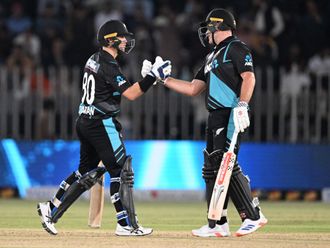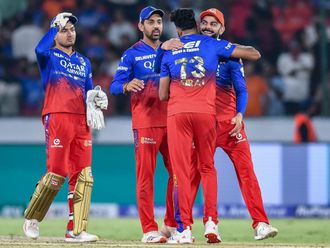London: One could be forgiven, when the England touring party to visit Australia was named last Wednesday, for thinking the pessimism was being a little overdone. The view was not just that the party is weak; but that it is weaker than most we have sent Down Under.
Yet, we sent a supposedly strong side to Australia four years ago — they had just won the first half of back-to-back series 3-0 — and were still thrashed 5-0. One of our leading batsmen, Jonathan Trott, departed early on with the cricketing equivalent of shell-shock; our leading slow bowler, Graeme Swann, who had taken 26 wickets in the series in England, retired before the Melbourne Test, when the Ashes had already been lost. He said later that he was in “a horrible downward spiral” and, of his bowling, “quite frankly, I was awful”.
If that bodes badly for this year’s tourists, consider another case. In 1986 England lost two series to India and Pakistan, following a 5-0 thrashing by the West Indies in the Caribbean. Martin Johnson, a leading cricket writer, said there were only three things wrong with the England team: they couldn’t bat, they couldn’t bowl, and they couldn’t field.
Australia were in poor shape too, but it was still predicted that they would be no pushover: yet they lost 2-1 to England. When one looks at the team on paper they weren’t bad: Botham and Lamb, Edmonds and Emburey, Gower and Gatting all have the ring of class about them. But the team were malfunctioning, low in self-confidence, and with too many weak links.
When the side lost their first warm-up match, to Queensland, by five wickets, those who had written them off before they had got to Heathrow started to feel vindicated: yet, against an ailing Australia, they came good.
Until someone who is allegedly Ben Stokes allegedly became involved in the sort of alleged punch-up that normally causes one to feel such despair about association footballers, there were still enough high-class players in the Ashes party to make one feel England would not necessarily crawl home in shame.
We may have only one opening batsman, but, in Alastair Cook, we have a superb one with huge experience and, more to the point, huge experience of Australian conditions. There is the magnificent Joe Root; in Jonny Bairstow, a wicketkeeper-batsman of rare talent; in Moeen Ali a formidable batsman who has developed real ability as a spinner; and in Jimmy Anderson and Stuart Broad as good a pair of opening bowlers as one could find on the planet.
But if Stokes does not tour – the England and Wales Cricket board have confirmed he will not travel with the England squad to Australia on October 28 but no final decision on his involvement in the Ashes has been taken – the whole balance of the side is altered. They lose a batsman who can come in when two, three and five have failed, and become the pivot of a revival.
They lose a bowler who can be relied upon to come on first change and be threatening and penetrating in the manner of the man he has replaced.
If he is found to have behaved as is alleged, whatever may or may not have been the provocation, then the book, or a whole shelf of books, should be thrown at him. But the gap he would leave in that event cannot be filled, and there is no point pretending it can.
Profound question
England have sometimes toured Australia without potentially their best player. Graham Gooch missed the 1986-87 tour for personal reasons: Geoffrey Boycott was in self-imposed exile in 1974-75. Despite the huge talent of both men, their absences did not, in all probability, affect the outcome of either tour. It would be a brave person who said the same about the effect of Stokes missing the impending tour.
It’s only a game: but whatever punishment is inflicted on him a measure of opprobrium should be reserved for the England management, whose permissive attitude towards young men with full wallets, strong thirsts and short tempers is little short of irresponsible.
The Stokes debacle was entirely avoidable. But there is a more profound question.
For a start, the pool in which the selectors now fish is effectively shrunk by the two-division County championship.
Those who swim in the second division do not, by definition, play against their best peers, and the gap between standards in the second division and Test cricket is becoming enormous. Yet, there are more deep-seated problems still.
With local clubs closing down every season, more and more state schools not playing cricket and the exam time table seriously shortening the season even in independent schools, the numbers of young men contending for a place in county colts sides, second XIs and championship teams are also shrinking. The work of the MCC Foundation, in trying to provide facilities for boys and girls in state schools to play cricket, is an admirable enterprise, but it may not be enough.
And so long as Test cricket is not available on free-to-air television, the chances of inspiring another generation are being severely limited.
But even when someone with a talent that approaches Stokes’s comes through, the emphasis is on him succeeding in short-form cricket, because it is so lucrative both for the player and for his team.
England talk much about preparation, rest and training as a measure of their superior approach to Test cricket now, but it would be foolish for the ECB to imagine that it can undermine and run down the County Championship for 20 years, and do too little to ensure young people play cricket irrespective of their backgrounds, and still hope to have a steady supply of highly talented cricketers to lead a successful and impressive Test side into the 2020s.
With luck the pessimists are wrong, and the coming tour, even if it takes place without Stokes, will be rich in achievement. Sadly, however, if it is a catastrophe, the ECB is simply likely to regard it as further proof that Test cricket has had it, and that T20 is the only game in town.
— The Telegraph Group Limited, London 2017












